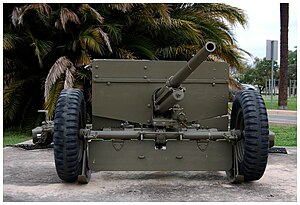37 mm Gun M3
| 37mm Gun M3 on Carriage M4 | |
|---|---|

M3 on display at Fort Sam Houston, Texas.
|
|
| Type | Anti-tank gun |
| Place of origin | United States |
| Service history | |
| Used by | United States National Revolutionary Army Brazil |
| Wars |
World War II Second Sino-Japanese War |
| Production history | |
| Designed | 1938 |
| Manufacturer | Gun: Watervliet Arsenal, Carriage: Rock Island Arsenal |
| Produced | 1940–1943 |
| Number built | 18,702 |
| Specifications | |
| Weight | 413.68 kg (912.01 lb) |
| Length | 3.92 m (12 ft 10.3 in) |
| Barrel length | overall: 2.1 m (6 ft 11 in) L/56.6 bore: 1.98 m (6 ft 6 in) L/53.5 |
| Width | 1.61 m (5 ft 3.4 in) |
| Height | 0.96 m (3 ft 1.8 in) |
| Crew | 4–6 |
|
|
|
| Shell | 37×223 mm. R |
| Caliber | 37 mm (1.45 inch) |
| Breech | vertical block |
| Recoil | hydrospring |
| Carriage | split trail |
| Elevation | -10° to +15° |
| Traverse | 60° |
| Rate of fire | up to 25 rpm |
| Muzzle velocity | up to 884 m/s (2,900 ft/s) |
| Maximum firing range | 6.9 km (4.29 mi) |
| Sights | telescopic, M6 |
The 37 mm Gun M3 was the first dedicated anti-tank gun fielded by United States forces in numbers. Introduced in 1940, it became the standard anti-tank gun of the U.S. infantry with its size enabling it to be pulled by a jeep. However, the continuing improvement of German tanks quickly rendered the 37 mm ineffective, and by 1943 it was being gradually replaced in the European and Mediterranean theaters by the more powerful British-developed 57 mm Gun M1. In the Pacific, where the Japanese tank threat was less significant, the M3 remained in service until the end of the war.
Like many other light anti-tank guns, the M3 was widely used in the infantry support role and as an anti-personnel weapon, firing high-explosive and canister rounds.
The M5 and M6 tank mounted variants were used in several models of armored vehicles most notably in the Stuart Light Tank M3/M5, the Lee Medium Tank M3, and Greyhound Light Armored Car M8. In addition, the M3 in its original version was mated to a number of other self-propelled carriages.
In the mid-1930s, the United States Army had yet to field a dedicated anti-tank artillery piece; anti-tank companies of infantry regiments were armed with .50 in (12.7 mm) machine guns. Although there was some consideration had been given to replacing the machine guns with a more powerful anti-tank gun, the situation only began to change after the outbreak of the Spanish Civil War. Combat experience from Spain suggested that a light anti-tank gun, such as the German 37 mm PaK 35/36, was capable of neutralizing the growing threat posed by tanks.
...
Wikipedia
